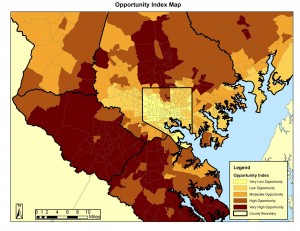The Society for American City and Regional Planning History’s biannual meeting in Baltimore November 17-20 addressed a number of important aspects of urban poverty, including a tour and symposium focused on Baltimore itself. It would take some concentrated effort to adequately summarize the array of material presented, but a few observations are in order. The tour featured the Baltimore Integration Partnership, yet one more effort to reverse the concentration of poverty and its ill effects in East and West  Baltimore. This program seeks to coordinate re-investment with job creation and training, drawing on a range of resources, including support from several foundations. Descriptions of the efforts left a number of questions unanswered, however, including how much community buy-in and input was involved. The program sounded a good deal like widely touted efforts, including the Enterprise Foundation’s initiative in Sandtown-Winchester and the empowerment zone program of earlier years. Associated Black Charities president Diane Bell-McCoy, speaking at the symposium on Baltimore’s Living Cities program that evening, has been centrally involved in each of these programs, and she warned against expecting any breakthroughs in the near future. A paper presented the following day by the University of Maryland’s Lynette Boswell suggested why. Tracing a succession of place-based investment strategies over the past generation, she showed that the level of inner-city poverty has scarcely budged over the past generation.
Baltimore. This program seeks to coordinate re-investment with job creation and training, drawing on a range of resources, including support from several foundations. Descriptions of the efforts left a number of questions unanswered, however, including how much community buy-in and input was involved. The program sounded a good deal like widely touted efforts, including the Enterprise Foundation’s initiative in Sandtown-Winchester and the empowerment zone program of earlier years. Associated Black Charities president Diane Bell-McCoy, speaking at the symposium on Baltimore’s Living Cities program that evening, has been centrally involved in each of these programs, and she warned against expecting any breakthroughs in the near future. A paper presented the following day by the University of Maryland’s Lynette Boswell suggested why. Tracing a succession of place-based investment strategies over the past generation, she showed that the level of inner-city poverty has scarcely budged over the past generation.
On November 20th, I chaired a session on regional equity, arguing that poorer residents were likely to do better by leaving the inner city behind. The session was organized in memory of John Payne, a distinguished professor of law, whose work has recently been memorized by Rutgers-Newark’s law journal. In addition to addressing issues of affordable housing and the relative school performance of poor children who move out of the inner city, the session looked at the experiences of court-mandated relocation of the poor outside Baltimore.
Peter Rosenblatt showed definitively that those children whose families took advantage of court-mandated move-to-opportunity directives were doing better in school and adults in their households, even in second moves, were taking advantage of greater centers of opportunity. The numbers are relatively small, and much more needs to be done to track and evaluate the experience of those moving out of the inner city, but Rosenblatt’s presentation helped highlight the need to tie inner city re-investment to a larger regional strategy. Obviously, the more the ambitious poor move out, the more hollowed out the central core will become. Still, it appears that efforts to alleviate poverty are advancing without a comprehensive strategy and thus leave their prospects for success very much up in the air.
